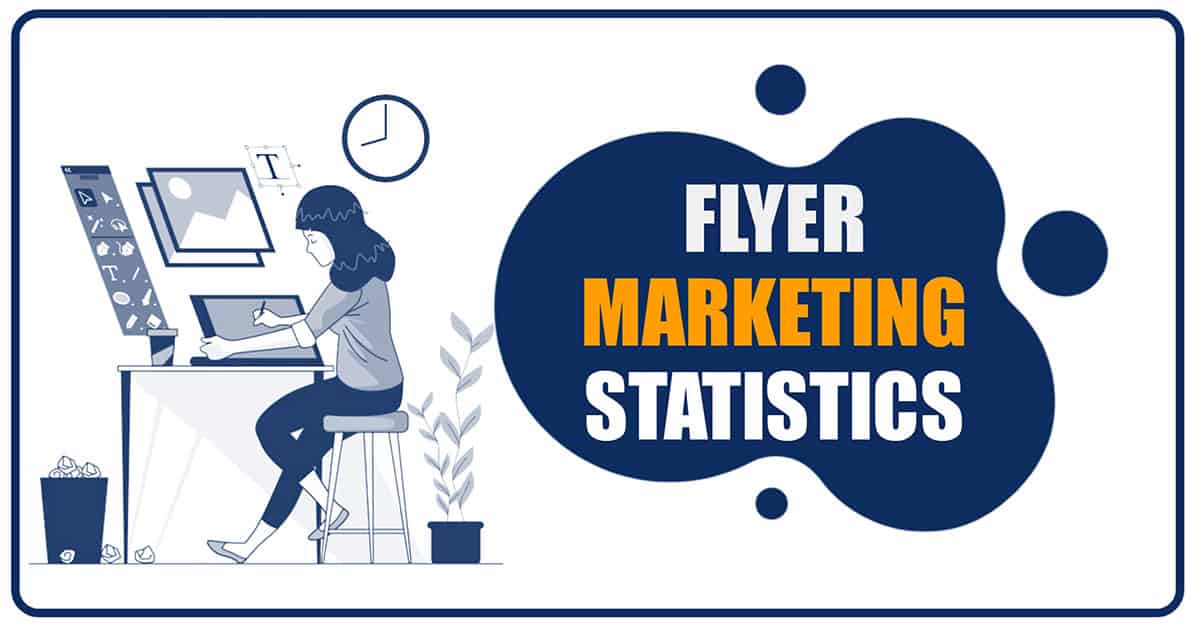In an age where digital ads flood our screens, flyer marketing continues to stand out, literally.
Surprisingly, 89% of people remember receiving a flyer, proving that tangible ads leave a lasting impression in ways digital campaigns often can’t.
Even more compelling, flyers generate 1% and 5% response rates, making them highly effective tools for businesses seeking attention.
But what makes flyers so powerful? Smart design and strategic distribution. With the right approach, flyers can achieve up to 3.4% conversion rates, turning simple pieces of paper into high-impact marketing tools.
In this article on flyer marketing statistics, I discuss how flyer marketing offers a cost-effective, memorable, and results-driven solution.
1. The response rate for flyer marketing is between 1% and 5%.
(Post Grid)
This means that for every 1,000 flyers distributed, you might expect 10 to 50 responses, and if you distribute 100 flyers, you can realistically expect between 1 and 5 positive responses.
When distributing flyers, you tap into a tangible medium that often captures attention more effectively than digital ads. A physical flyer can stand out for many consumers in an increasingly digital world.
Factors such as design, distribution method, and target audience play crucial roles in achieving these rates. Attractive graphics and clear messages can significantly enhance engagement.
2. 54% of consumers say they are more likely to buy a product after receiving a flyer.
(Metrobi)
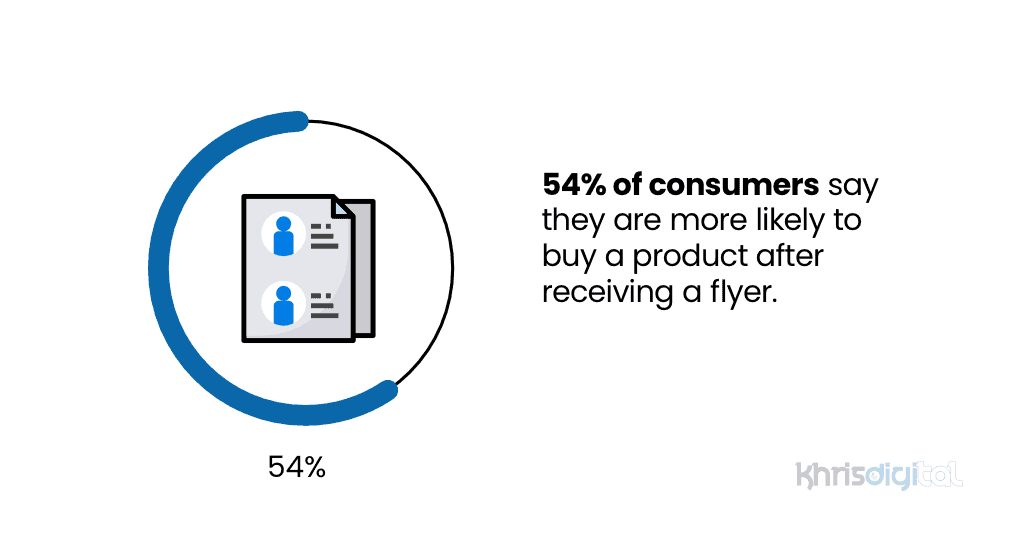
Many businesses use this statistic to enhance their marketing strategies. By strategically distributing flyers, they tap into the buying potential of a significant portion of the consumer market.
In practical terms, if you want to improve your sales numbers, consider investing in flyer campaigns. They help drive immediate sales and remind consumers of your brand, which they might keep for later reference.
Engaging consumers through tangible and visually appealing flyers can guide them toward purchasing, turning a simple ad into a valuable asset for your business.
3. 70% of consumers are influenced by flyers when making purchase decisions.
(WinSavvy)
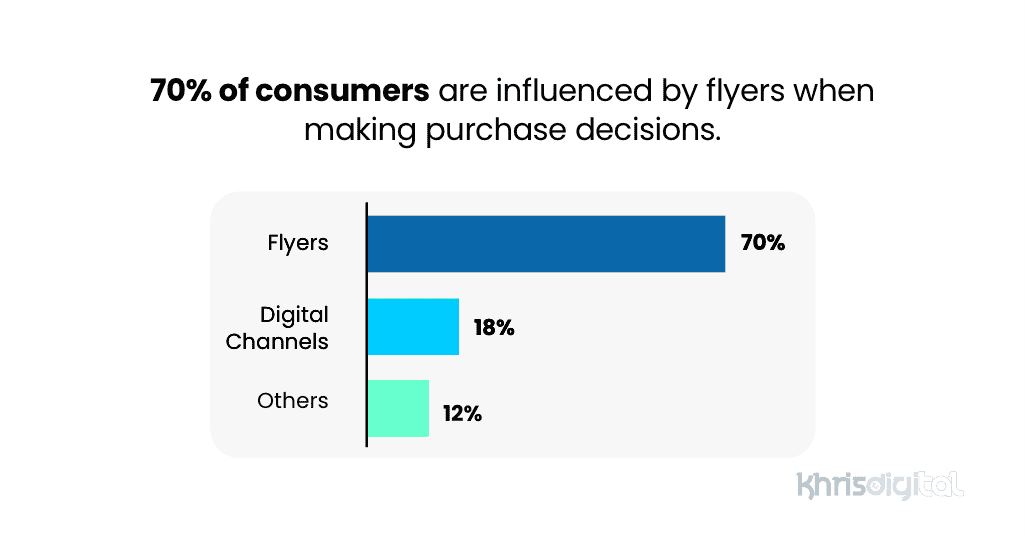
Flyers are easy to overlook when considering advertising methods. Many consumers still appreciate the physical presence of a flyer, as it provides a sense of personal connection that digital advertisements often lack.
Collaborating with local businesses or events can amplify your flyer distribution. This strategy broadens your reach and creates a sense of community, making your message even more relatable.
Incorporating discounts or exclusive offers can make your flyers even more attractive. When potential customers see something piques their interest, they are more likely to act quickly.
4. 57% say flyers make them feel more connected to the business.
(WinSavvy)
Physical materials like flyers can create a sense of authenticity. When you hold a flyer, you’re engaging with a tangible representation of a brand, unlike digital ads that can feel transient.
Flyers also have a unique ability to convey local presence. They can feature community events, local offers, or personalized messages that resonate more profoundly with consumers. This local touch cultivates a sense of familiarity and trust.
5. 39% of consumers try a business for the first time because of a flyer they received.
Flyers pique curiosity. They can showcase a brand’s unique offerings or promotions in a concise format. You can use bold images and engaging text to draw attention and create interest among potential customers.
As you design your flyer, remember to focus on a clear message and a strong call to action. Whether it’s an invitation to visit your store or check out a website, clarity will guide new customers to take the next step.
6. 56% of consumers find print marketing, including flyers, to be the most trustworthy type of marketing.
(Data and Marketing Association)
This preference likely stems from the tangible nature of print materials. Holding a flyer in your hand feels more substantial than an ephemeral digital ad. It’s a concrete piece of information that can be reviewed and shared.
Moreover, trust plays a crucial role in consumer decision-making. People often seek reassurance before engaging with brands. When consumers see a flyer, it usually conveys a sense of credibility that digital marketing may lack, especially in a crowded online space.
You can leverage this trust in your marketing campaigns. You create a well-rounded approach that appeals to diverse consumer preferences by prioritizing print marketing alongside digital efforts.
7. 89% of people remember receiving flyers.
(Oppizi)
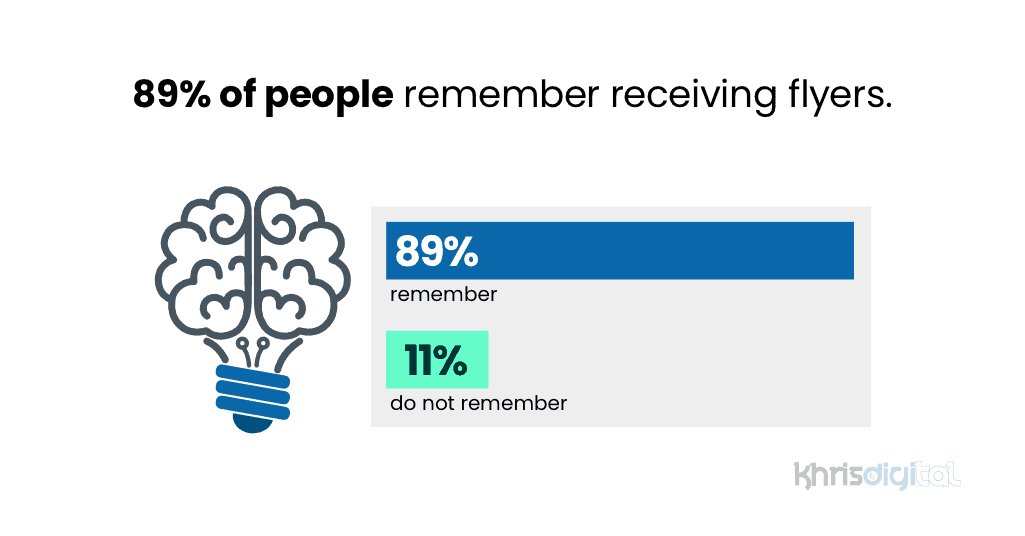
You may wonder why this recall rate is so high. Flyers offer a tactile experience that other digital forms of advertising often lack. They allow consumers to hold something tangible, which can enhance memory retention.
Another factor is the visual appeal of flyers. A well-designed flyer can capture attention quickly. Bright colors, clear calls to action, and engaging graphics make a flyer stand out in a pile of mail.
8. 67% of flyers are kept for more than a week.
(WinSavvy)
The extended retention time means your marketing message has the opportunity to resonate. If your flyer ends up in your audience’s home, it can stay on their minds longer than expected.
Why does this matter? It shows that flyers are not just a brief moment of attention; they can linger, influencing decisions. When consumers keep a flyer, they might reference it later when choosing your product or service.
9. 45% of people retain flyers for future reference.
(Oppizi)
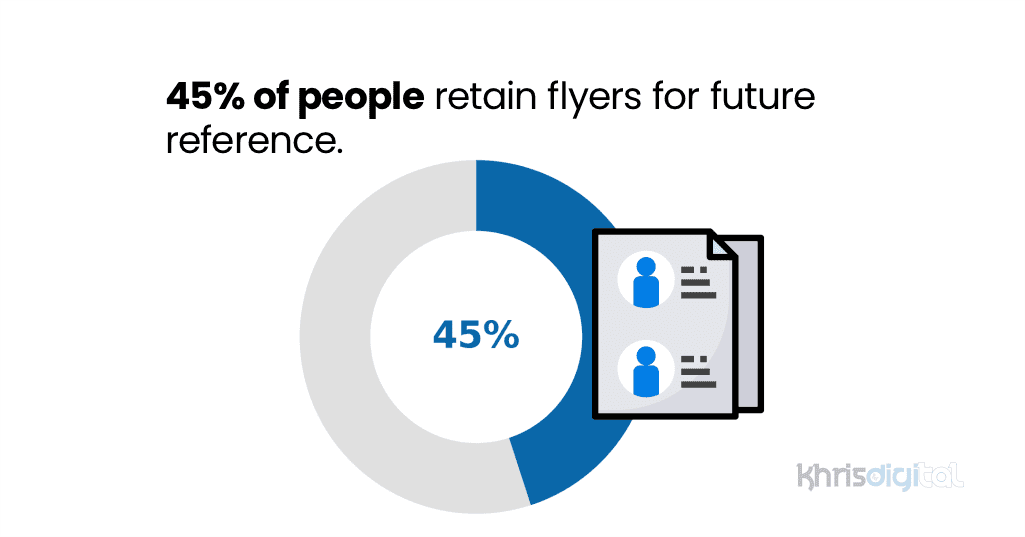
People often retain these flyers for various reasons. For instance, they might find the information relevant, entertaining, or valuable. This retention can lead to future business, as customers may revisit your flyer when ready to purchase.
To maximize retention, ensure your flyer is visually appealing and informative. Use bold headlines and clear calls to action. Additionally, including a discount code or special offer can entice individuals to hold onto your flyer for future use.
Unique URLs or QR codes can help you track the effectiveness of your flyer. These codes help assess how many people engage with your content after retaining it.
10. 90% of flyers are opened, compared to 20-30% of marketing emails.
(Embryo.com)
Several factors contribute to this captivating difference. Physical presence plays a crucial role. A flyer in hand creates a tangible connection that digital formats struggle to achieve.
Additionally, people often associate direct mail with personal communication. When you receive a flyer, it feels less like marketing and more like a message specifically for you.
Opting for flyers can direct more attention to your brand. They can stand out in a world inundated with digital noise. When sending a flyer, you give your audience something physical to hold and read.
11. 62% of respondents would be more likely to do business with a company if they received a flyer.
(Leaflet Distribution Team)
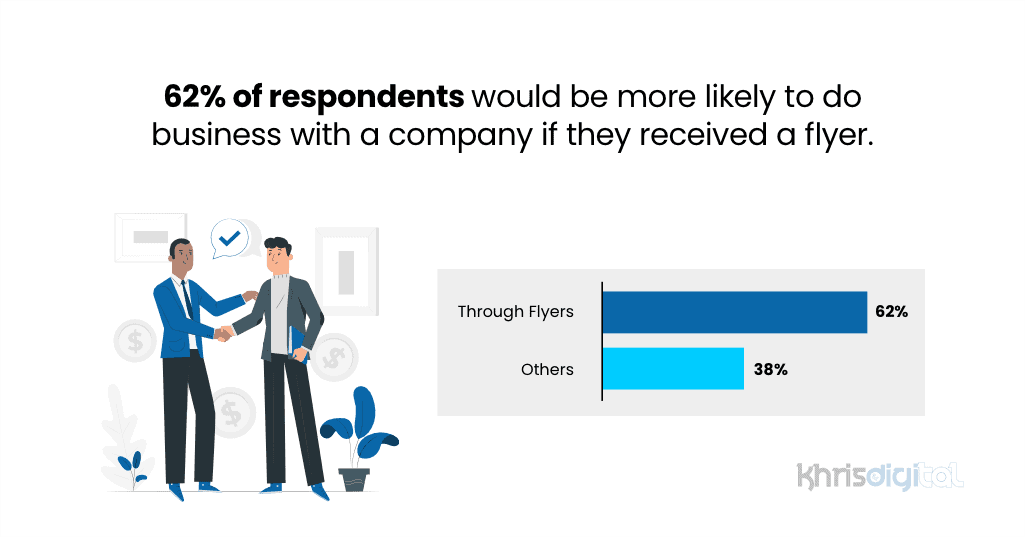
Interestingly, the tactile aspect of a flyer often increases its impact. When customers have something physical to hold, it can enhance recall and recognition of your brand.
Additionally, flyers are cost-effective compared to other advertising methods. This allows you to reach a wider audience without breaking your budget.
Many businesses are recognizing this potential. Incorporating flyers into your marketing strategy can enhance your visibility and improve your chances of attracting new customers.
12. Flyers average 29% return on investment (ROI).
(WinSavvy)
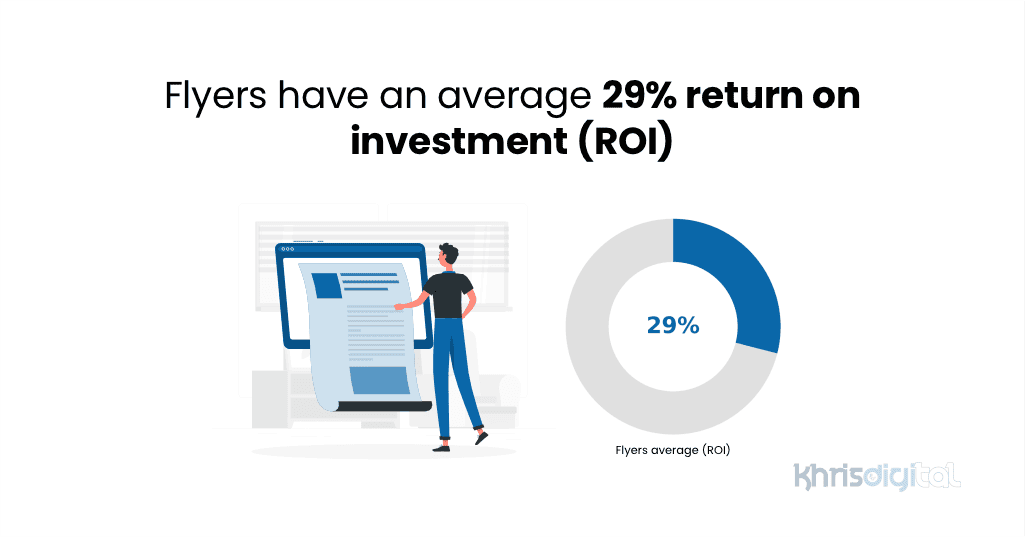
This statistic indicates that for every dollar spent on flyer marketing, you can expect a return of nearly a third. This figure compares favorably against other media. For context, online display ads offer an ROI of about 16%, while paid search ads reach about 23%.
Many businesses have found success by integrating flyers into their marketing strategy. Flyers can enhance brand visibility and drive customer engagement. Utilizing eye-catching designs and clear calls-to-action can further improve this ROI.
13. Recipients of flyers have a 70% higher brand recall than digital ads.
(Market Anywhere)
Research shows that physical formats like flyers engage recipients differently. Holding a flyer creates a tactile experience that digital ads cannot replicate. This physical presence fosters stronger memory associations.
Why are flyers effective? One reason is that they often remain in view longer than digital content. Many recipients store flyers for later reference, increasing their chances of remembering the brand.
Moreover, flyers can effectively target specific demographics. Research indicates that younger audiences respond well to print media, including flyers.
14. The cost per thousand (CPM) for flyer distribution can be as low as $0.30.
(Metrobi)
This cost allows you to allocate your marketing budget effectively. Imagine distributing 1,000 flyers for just $300. You’d gain exposure without breaking the bank.
You can maximize this cost-efficiency by ordering flyers in bulk. Bulk printing reduces individual costs, allowing you to spread your message farther.
Additionally, consider combining flyer distribution with other marketing channels. This multi-channel approach can reinforce your message, ensuring potential customers see your brand through various platforms.
15. 62% of businesses say their flyer campaigns lead to new customers.
(WinSavvy)
Flyers offer potential customers a tangible way to engage with your brand. They often create a personal touch that digital ads may lack. You can use eye-catching designs and clear messages to reach your target audience effectively.
If 62% of businesses succeed with flyers, it might be worth exploring how your campaigns can leverage this traditional method. Tailoring your message and design can significantly impact attracting new customers.
16. 55% of businesses report that flyers help them stand out from competitors.
(WinSavvy)
When designing your flyers, consider the elements that enhance visibility. Key components are unique design, clear messaging, and a call to action. Your flyer should grab attention and encourage potential customers to learn more about your offer.
Peer businesses have seen a noticeable impact from their flyer campaigns, showcasing a connection between effective design and competitive advantage. Utilizing this medium boosts brand awareness and creates a lasting impression.
17. 59% of businesses experience an increase in sales after a flyer campaign.
(WinSavvy)
Understanding why flyers work can provide valuable insight. For one, they are often highly targeted, reaching potential customers directly in their local area. This direct approach allows your message to engage consumers interested in your offerings.
Moreover, flyers can be designed to capture attention visually. Bold graphics and clear calls to action can lead to immediate consumer interest and prompt quick responses. A well-crafted flyer can significantly affect how your promotion is received.
Additionally, flyer campaigns are generally cost-effective. They can deliver a strong return on investment, especially compared to digital-only strategies. The ability to distribute them through door drops or local events enhances their effectiveness.
18. 78% of small businesses use flyers as part of their marketing strategy.
(Oppizi)
Why do so many businesses favor flyers? One reason is their ability to reach a local audience effectively. Flyers can be distributed in targeted areas, ensuring your message reaches potential customers right where they are.
The statistic also signifies a shift towards a balanced marketing strategy. Many small businesses combine traditional methods like flyers with digital channels, enhancing their reach and impact.
19. 79% of households either read or scan advertising mail, including flyers.
(B&B Press)
Consider this: when you receive a flyer, you will likely glance at it. You might not read every word, but the visuals and key messages can draw your interest. This is a crucial aspect for businesses to remember while designing their flyers.
Research shows that 23% of recipients take the time to read flyers thoroughly. This implies that while many may scan, a notable portion engages deeply with the content.
In contrast to digital advertisements, which can be easily ignored, printed flyers often find a place in your home. They become a part of your environment, sometimes leading to spontaneous decisions or purchases.
20. 45% of consumers visit a website after receiving a flyer.
(4 OVER 4)
Think about it: a well-designed flyer can capture attention with vibrant visuals and clear messaging. When potential customers receive a flyer, it can pique their interest enough to explore the brand’s website for more information.
To maximize this potential, ensure your flyer includes clear calls to action (CTAs) such as URLs or QR codes. This makes it easier for recipients to navigate directly to your site.
21. Flyers with a discount code are 50% more likely to be kept for at least a week.
(Post Grid)
A discount code can spark greater interest. Consumers are motivated by savings, which encourages them to hold onto the flyer. Keeping a flyer for over a week allows consumers to reflect on their purchasing decisions. This means your promotion stays at the top of your mind longer.
The combination of visual appeal and financial incentive makes for an engaging flyer that people will likely keep and refer to later.
22. 78% of respondents report they glance at leaflets they receive, and 23% read them carefully.
(Tailor Brands)
Knowing how many people glance versus those who read can guide your approach. If you can grab attention quickly, you increase the likelihood of deeper engagement from that 23%. Use this data to refine your messaging and improve overall response rates.
By focusing on design and content, you can effectively reach the majority who glance and capture the interest of those who read.
23. 79% of consumers keep, pass on to a friend, or glance at the contents of flyers they receive.
(Direct Letterbox Marketing)
Many people appreciate tangible information. Flyers provide a convenient way to communicate offers and promotions directly to your audience. This statistic highlights the power of printed marketing materials in an increasingly digital world.
This retention and sharing statistic underscores the importance of quality design and relevant information. By creating a flyer that resonates with your audience, you increase the likelihood that they’ll keep it for later reference or share it with others.
24. 63% of millennials who responded to a flyer purchased within a week.
This statistic highlights the effectiveness of flyers in capturing attention. Millennials are often seen as mobile-first, yet they resonate deeply with tangible materials like flyers.
Incorporating this knowledge into your marketing strategy may improve engagement rates. The data indicates that Millennials are more likely to act quickly upon seeing beneficial offers in flyer form.
25. 71% of people who receive a flyer take action based on the content.
(WinSavvy)
This level of engagement suggests that flyers are more than just paper advertisements. They serve as a compelling call to action.
Consider how this statistic reflects consumer trust. When you receive a flyer, it often carries a message or offer that resonates with your needs. This connection can prompt you to engage more actively than with digital advertisements.
The tactile nature of flyers also plays a role. Unlike scrolling through online ads, holding a flyer can create a personal connection. The content is right in your hands, so you may be more likely to remember the details.
26. 32% of businesses report increased brand awareness due to flyer marketing.
Flyers can be a powerful reminder of your brand in potential customers’ hands. A well-designed flyer can create a lasting impression that digital ads might not achieve.
Additionally, other marketing statistics highlight that 81% of consumers need to trust a brand before purchasing. This means that increasing brand awareness through flyers can build that necessary trust.
By leveraging flyer marketing, you can effectively elevate your brand presence in your community. Whether you’re a small business owner or part of a larger company, consider integrating flyers into your marketing strategy for noticeable results.
27. 64% of consumers have visited a store in person after receiving a flyer.
(Journal of Retailing and Consumer Services)
This suggests that flyers can effectively drive foot traffic. Flyers often highlight enticing promotions, inviting events, or exclusive offers that catch people’s attention. These elements encourage customers to take action and visit your store.
The effectiveness of flyers lies not just in their distribution but also in their ability to connect with an audience locally.
28. 82% of businesses see increased foot traffic when using flyer marketing.
Why does this happen? Flyers serve as visual invitations that catch the eye of potential customers. Whether placed strategically in busy areas or distributed directly, their tactile nature can prompt recipients to visit your establishment.
Additionally, flyer marketing’s effectiveness can be enhanced with other advertising forms. For instance, integrating flyers with digital ads can further amplify your reach.
With such a high percentage of businesses noting increased foot traffic, flyer marketing is a worthwhile strategy to explore.
29. 53% of customers consider flyers to be more credible than online ads.
When you receive a physical flyer, it often feels more tangible and personal. This perception can enhance the credibility of the message being communicated. Many individuals appreciate the effort that goes into creating and distributing printed materials.
In contrast, online ads can often seem overwhelming and misleading. You may encounter numerous ads daily, making differentiating genuine from exaggerated ads difficult.
Flyer marketing also benefits from a personal touch. It allows businesses to convey their message without the distractions often found in digital environments. Customers can easily reference a flyer at their convenience, further enhancing its credibility.
30. 68% of consumers find flyers more personal than digital ads.
(WinSavvy)
Flyers create a tangible experience that digital ads often lack. When you receive a flyer, it engages your senses in a way that a screen simply cannot. The physical presence of a flyer makes it more likely for you to remember the message.
Many consumers appreciate the personal touch of direct mail. According to various studies, 68% of people feel that flyers resonate more because they are a direct, physical interaction.
This connection can foster trust and credibility, elements sometimes missing in digital communications.
31. 70% of people find flyers more personal than digital marketing.
(WinSavvy)
This preference stems from the tangible nature of flyers. Unlike emails or online banners, a flyer physically arrives in your mailbox, creating a sense of direct communication. This physicality can evoke feelings of importance and familiarity.
Moreover, flyers can convey a sense of local presence. When you receive a flyer from a nearby business, it feels like a direct invitation tailored for you. This connection is often missing in digital marketing, which can seem impersonal and generic.
32. 49% of businesses use flyers to promote special offers and discounts.
Nearly half of businesses today use flyers to promote special offers and discounts, highlighting their ongoing relevance in marketing.
Flyers provide a cost-effective way to reach your target audience. They can effectively communicate time-sensitive deals, ensuring that your promotions capture the attention of potential customers.
33. 77% of people read a flyer they receive in their mailbox.
Unlike digital ads that can easily be ignored, flyers demand attention. Their tangible nature means you physically hold the information, making it more likely to engage you.
Consider this: You might glance through the mail and notice a colorful flyer. If it piques your interest, you may read about the latest offers or events. This interaction has significant implications for marketers.
It’s worth noting that 79% of consumers also keep flyers. This means people read them and often hold onto them for later reference. With the right design and messaging, your flyer can serve as a lasting reminder of your brand.
34. 44% of people keep a flyer on their fridge or bulletin board.
(WinSavvy)
You may wonder why this matters. Flyers that are displayed prominently act as a constant reminder of promotions or services. This visibility increases the likelihood that people will engage with your content.
Understanding this statistic can help shape your flyer design. Eye-catching graphics and clear messaging can entice a potential customer to keep your flyer within view.
35. Flyers are retained for an average of 17 days
Unlike other forms of advertising, flyers often end up repeatedly in places where they can be seen. You might find them on a fridge, pinned to a bulletin board, or even in a mail stack. This extended presence is a unique advantage.
Several studies reinforce this average retention. For instance, 38% of flyers are kept for a few days, and 13% retain them for over a week. These numbers show that many individuals glance at flyers and choose to hold onto them.
Final Thoughts on Flyer Marketing Statistics
Flyer marketing proves that traditional methods still sometimes pack a punch. When strategically designed and distributed, flyers remain cost-effective in grabbing attention and driving action.
Response rates can reach up to 5% or more. Their tangible nature fosters a sense of trust that digital ads often struggle to replicate.
But success is about smart execution. Eye-catching visuals, compelling copy, and clear CTAs can significantly boost engagement.
Whether you’re promoting a local business, an event, or a special offer, flyers can be a powerful tool when used effectively.
Integrating flyers with digital strategies like QR codes linking to exclusive deals can enhance their impact as marketing evolves. The key takeaway?
Print isn’t dead, it’s just getting smarter.
Sources:
Frequently Asked Questions
What is the success rate of flyer marketing for small businesses?
The response rate for flyer marketing typically averages around 3.5%, significantly higher than digital marketing’s average of about 1.1%.
How does the flyer marketing strategy impact the overall effectiveness of the campaign?
The strategy employed in flyer marketing plays a crucial role in determining its effectiveness. Targeting the right audience, crafting compelling messages, and choosing appropriate distribution methods can enhance visibility and response rates. Personalization in flyers also increases engagement.
What factors contribute to the effectiveness of flyers as a promotional tool?
These factors include design quality, message relevance, distribution timing, and location. Flyers that are visually appealing and provide clear calls to action tend to generate better responses.
What are the common reasons behind the ineffectiveness of flyer advertising?
Poor audience targeting, unappealing designs, and a lack of clarity in messaging are common issues. Additionally, distributing flyers in low-traffic areas or failing to follow up can diminish their impact.
How does flyer distribution compare to other marketing methods in terms of efficacy?
Flyers have a higher response rate than online advertisements, suggesting that physical marketing materials have unique advantages in specific contexts, especially for local promotions.
Check out my other Statistics round-up:

